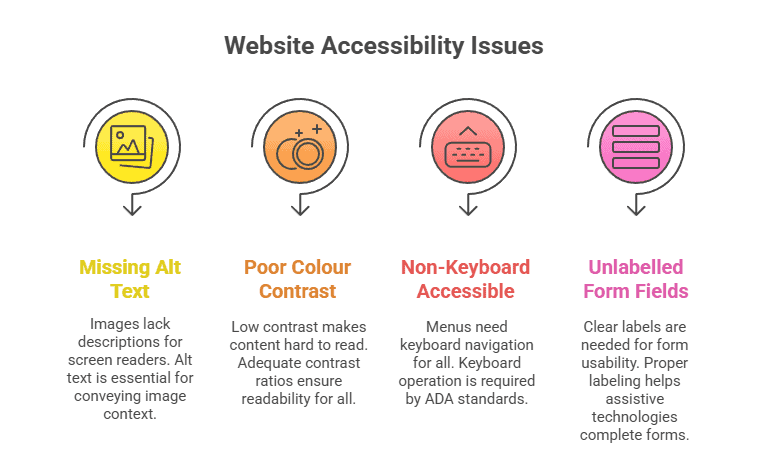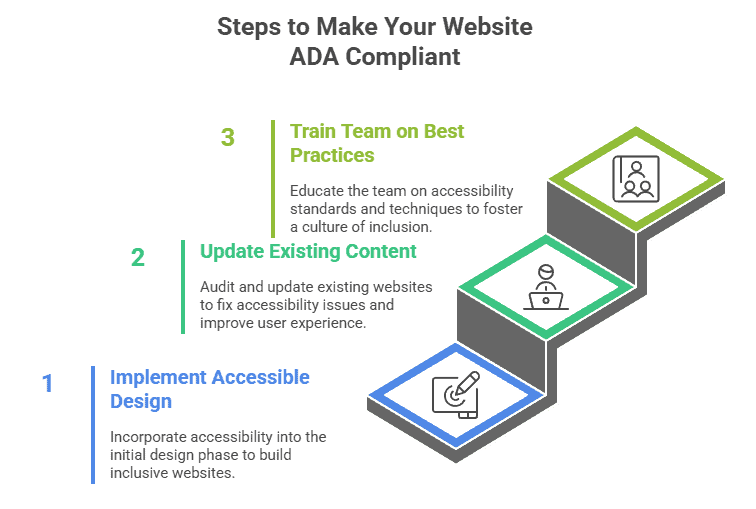Le Loi sur les Américains handicapés (ADA) is a landmark civil rights law enacted in 1990 to prohibit discrimination against individuals with disabilities in all areas of public life. This includes employment, transportation, public accommodations, communications, and access to state and local government programs and services. The ADA aims to ensure that people with disabilities have the same rights and opportunities as everyone else, promoting equal access and inclusion across society.
Although the ADA was passed before the internet became ubiquitous, its requirements have been interpreted by courts and regulators to apply to websites and digital platforms. This means that businesses and organizations must ensure their websites are accessible to people with disabilities. Website accessibility under the ADA involves removing barriers that prevent users with visual, auditory, motor, or cognitive impairments from accessing content or navigating online services effectively.

Why ADA Compliance Matters for Your Website
Meeting ADA website compliance is not only a legal obligation but also a critical aspect of risk management. Non-compliance can lead to lawsuits, fines, and costly settlements. Courts have increasingly ruled that websites are places of public accommodation, and therefore must be accessible under the ADA. Failure to comply can result in legal action that damages an organization’s reputation and finances.
Beyond legal risks, ADA compliance offers significant benefits for both users and businesses. Accessibilité du site web provides a better user experience for everyone, including people with disabilities, older adults, and those using mobile devices or assistive technologies. By embracing accessibility, organizations expand their audience, improve customer satisfaction, and demonstrate social responsibility. This inclusive approach fosters brand loyalty and can even enhance search engine optimization (SEO).
Key Accessibility Standards and Guidelines
Website accessibility is guided by established standards that provide a framework for creating inclusive digital experiences. These standards not only support ADA compliance but also ensure that content is usable by people with diverse abilities and technologies. Among the most important are the Web Content Accessibility Guidelines (WCAG) and Section 508 requirements, both of which set clear benchmarks for accessibility and legal compliance.
WCAG Principles (Perceivable, Operable, Understandable, Robust)
Le Lignes directrices pour l'accessibilité des contenus web (WCAG) are internationally recognized standards developed by the World Wide Web Consortium (W3C) to provide a clear framework for accessible web content. WCAG is structured around four key principles: perceivable, operable, understandable, and robust (POUR). These principles ensure content can be perceived by all senses, navigated and operated using various inputs, comprehended by diverse users, and reliably interpreted by assistive technologies.
WCAG is closely linked to ADA website compliance, as many legal cases and regulations reference WCAG standards (particularly versions 2.0 and 2.1 at the AA level) as the benchmark for accessibility. Following WCAG helps organizations meet ADA requirements by addressing common accessibility barriers.
Section 508 Requirements for Federal and Public Sector Sites
Article 508 is a federal law in the USA that mandates electronic and information technology accessibility for federal agencies and entities receiving federal funding. It aligns closely with WCAG guidelines and sets technical standards to ensure digital content, including websites, is accessible to people with disabilities.
While Section 508 specifically applies to government agencies, its standards influence ADA compliance in the broader public and private sectors. Adhering to Section 508 requirements can help organizations meet or exceed ADA expectations and demonstrate a commitment to inclusivity.
Common Website Accessibility Issues
Many websites contain barriers that prevent people with disabilities from accessing content or completing tasks effectively. Common issues include missing alternative text for images, poor color contrast, lack of keyboard accessibility, and unlabeled form fields. Identifying and addressing these problems is essential for meeting ADA requirements and providing an inclusive user experience.

How to Check Your Website for ADA Compliance
Verifying that a website meets ADA requirements involves testing it from multiple angles. Automated tools can quickly flag common problems, but real accuracy comes from combining them with manual keyboard navigation and screen reader testing. This approach ensures accessibility barriers are identified and addressed effectively.
Automated Accessibility Scanners
Automated tools scan websites for common accessibility issues such as missing alt text, color contrast problems, and structural errors. These scanners provide quick initial assessments but cannot identify all issues, especially complex usability problems.
Manual Testing and Keyboard Navigation
Manual testing involves navigating the website using only a keyboard to ensure all interactive elements are accessible. This method reveals barriers that automated tools may miss, such as focus order and keyboard traps.
Screen Reader Compatibility Checks
Testing with screen readers like NVDA, JAWS, or VoiceOver helps verify that content is read in a logical order and that alt text and labels are meaningful and accurate. This testing ensures users relying on assistive technology can access all information with ease.
Steps to Make Your Website ADA Compliant
Achieving ADA compliance is an ongoing process that requires attention at every stage of a website’s lifecycle. From incorporating accessibility into the initial design to updating existing content and training teams on best practices, each step strengthens usability and ensures legal compliance. Following these steps creates a more inclusive online experience for all users.

Ongoing Monitoring and Maintenance
Maintaining ADA website compliance requires regular audits to identify new or recurring accessibility issues. As laws and standards evolve, staying informed about updates to WCAG, ADA regulations, and related guidelines becomes critical. Continuous monitoring and prompt remediation ensure long-term compliance and an inclusive user experience.
Embracing Accessibility for Legal Compliance and User Inclusion
Ensuring ADA website compliance is both a legal necessity and a commitment to accessibilité numérique. Adhering to standards such as WCAG and Section 508 helps organizations create websites that are accessible and usable for all users. Regular testing, ongoing maintenance, and staff training are key to sustaining compliance.
For more information, consult the official ADA guidelines et WCAG resources to support your compliance efforts.
